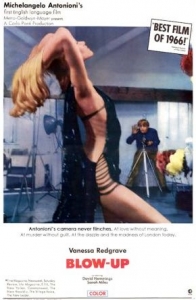| Back To News |
Celebrity photographer David Bailey: The man behind the (Olympus) camera!
posted Friday, April 18, 2014 at 1:50 PM EDT

In the Swinging Sixties, David Bailey was the most famous photographer in England. Young and cool, he partied with the Stones and the Beatles and was even known to hang out with gangsters like the notorious Kray Brothers. The main character in the 1966 Academy Award winning movie Blow-Up was in fact modeled after David Bailey.
Others photographed Bailey as much as he photographed others. So recognizable was he that Olympus hired him to appear in a series of humorous ads for their film cameras. The conceit behind these short pieces was that the 'serious' photographer in the scene would fail to catch the shot with his large, manual camera, while Bailey — in fact the accomplished professional — quietly shilled the features of his small Olympus.
Olympus cosponsored Formula 1 driver James Hunt and in this ad they put Bailey in the Olympus pit with his Trip AF, outshooting an obnoxious 'professional' photographer holding a 'real' camera.
Another ad found Bailey joined by Monty Python’s Eric Idle, who reprises his role in the 'nudge, nudge, wink, wink' skit, mistakes James Hunt for Dave Bailey. The conceit here is that the Olympus Trip is capable enough for David Bailey and easy enough for mere mortals.
In this earlier ad for the Olympus Trip, a wedding photographer scolds Bailey for not using a 'real' camera.
Next, at an exhibit of his photographs at London’s posh Park Village gallery, Bailey goes unrecognized by the obnoxious photographer extolling the virtues of his 'real' camera...until the reveal at the end.
Finally, here’s a 1989 ad with Bailey standing amidst the paparazzi who are shooting the celebs arriving at a restaurant, named – what else – the "Snapshot." The obnoxious paparazzi have big cameras, Dave Bailey has a tiny Olympus AF-10 Superzoom.
While Bailey is mostly a prop in these ads, his real life was extraordinary. Born to a poor family in 1938 in London's tough East End, his earliest memories were of the German bombing of London. He talks about that time as "living in a world of shattered glass." His education was spotty and he recalled one year where he went to school for just 33 days. He dropped out of school altogether at the age of 15.
By the dawn of the 60s, Bailey had established himself by working as a studio assistant around London. The sixties were a heady time and, along with photographer pals Terence Donovan and Brian Duffy, he found himself in the middle of Carnaby Street and the London music scene. The older British society photographer Norman Parkinson nicknamed them 'the Black Trinity.' They socialized with actors, musicians and royalty, and soon became celebrities in their own right. They were the first real celebrity photographers and their work defined the image of 'Swinging London.'
Soon Bailey was working for Vogue, at times shooting nearly 800 pages a year. The model Penelope Tree — once his girlfriend — described him at Vogue as, "the king lion on the Savannah: incredibly attractive, with a dangerous vibe. He was the electricity, the brightest, most powerful, most talented, most energetic force at the magazine".
Bailey worked with all the top models of the day but ultimately preferred Jean Shrimpton above all others. "She was magic and the camera loved her too. In a way she was the cheapest model in the world – you only needed to shoot half a roll of film and then you had it. She had the knack of having her hand in the right place, she knew where the light was, she was just a natural."
To get a feel for the real David Bailey, watch this recent TV interview in which the man behind the lens discusses his work.
When he talked of his work, Bailey said, "I've always tried to do pictures that don't date. I always go for simplicity."
(Source: http://en.wikipedia.org/wiki/David_Bailey)